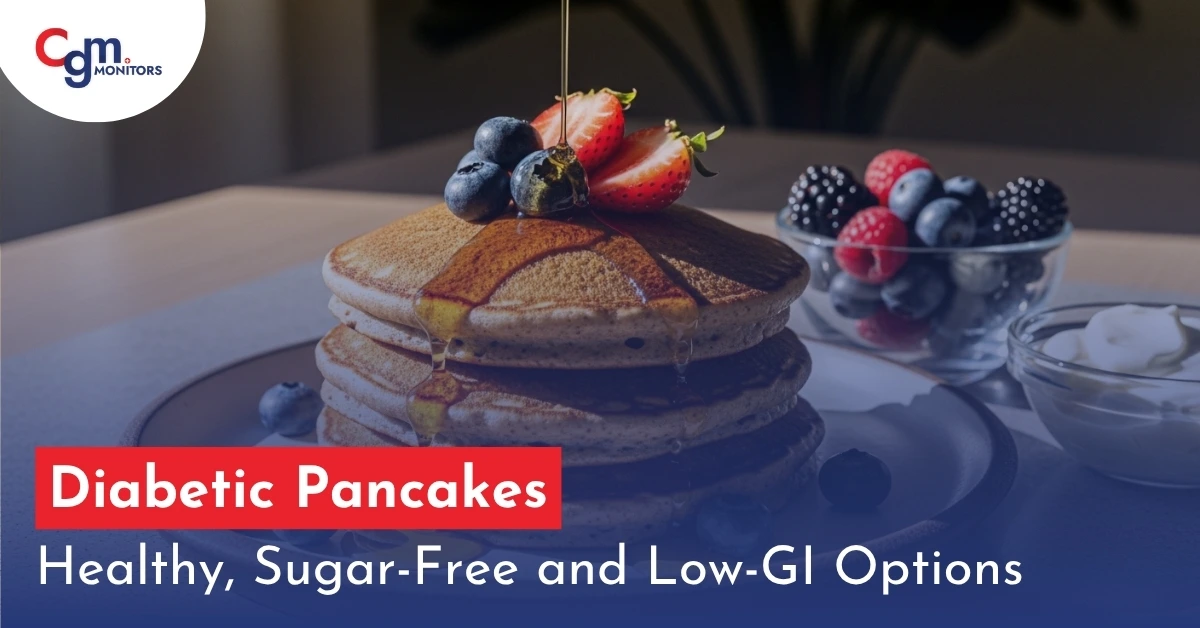Table of content
If you’ve ever asked, “Can diabetics eat pancakes?” The answer is yes, but you should make modifications to a traditional recipe by adding low glycemic ingredients and being mindful of portion sizes. The phrase “diabetic pancakes” is gaining traction and for good reason. We all love a fluffy pancake stack, but when managing diabetes, the traditional version can throw your blood sugar on a roller-coaster.
In this blog, we’ll explore why regular pancakes aren’t ideal, how you can make them diabetic-friendly. With ingredient alternatives, you can enjoy breakfast while managing your glucose. Apply smart nutrition and portion control to stay healthy and satisfied. We’ll also weave in how monitoring tools like the ones from CGM Monitors tie into smart meal planning for people with diabetes.
Why Traditional Pancakes Aren’t Ideal For Diabetics
The traditional pancakes use refined white flour and sugar, a high amount of carbohydrates. They have a high glycemic load, which leads to a rapid spike in blood sugar. People who eat regular pancakes can experience higher peaks and an increased risk of complications. The Journal of Nutrition (2020) found that a diet rich in refined carbohydrates like like traditional pancakes, waffles, or pastries, leads to higher HbA1c levels.
What is Diabetic-Friendly Pancake?
A diabetic-friendly pancake has a low glycemic index. The secret is in the flour. Try whole wheat rich with fibers, almond flour, or oats for the best. Skip the added sugar and go for sugar-free options instead. Add some fiber and protein like chia seeds, flaxseeds, psyllium husk, black beans, kidney beans, lima beans, lentils, chickpeas, peas to make it more filling. Keep your portions small, and cook with little or no fat. That’s how you make tasty, low-fat pancakes for diabetes!
How to Make Diabetic-Friendly Pancakes
Making diabetic pancakes doesn’t require fancy equipment, just a few tweaks to your routine. The first thing is to choose the right flour that contains lower carbs and is rich in fiber like almond and oat. Next, increase protein by adding ingredients like eggs or Greek yogurt to balance the meal and don’t add refined sugar. You can use an alternative thing like a natural sweetener (stevia) instead of refined sugar
1. Choose Low-GI Flours
Using the right flour can make or break your pancake recipe.
Best options include:
- Almond flour pancakes for diabetes: Naturally low-carb and packed with protein.
- Oatmeal pancakes for diabetics: Contain soluble fiber that helps stabilize blood sugar.
- Whole wheat pancakes for diabetics: A wholesome alternative with a moderate GI.
- Gluten-free diabetic pancake recipes: Ideal for those with gluten sensitivity.
These flours digest slowly, preventing blood sugar spikes and keeping you full longer.
2. Skip the Sugar, Keep the Sweetness
Replace refined sugar with natural, low-GI sweeteners like:
- Stevia
- Monk fruit extract
- Allulose
These alternatives provide sweetness without affecting blood glucose, making them perfect for low-sugar pancakes for diabetics.

3. Add Protein and Healthy Fats
Protein slows digestion and helps manage glucose levels. Try Add:
- Greek yogurt or cottage cheese to the batter.
- Egg whites for extra protein.
- Chia or flax seeds for omega-3 fats.
This makes your recipe a high-protein, diabetic-friendly pancake option.
Delicious Pancake Recipe for Type 2 Diabetics
Here are some pancake ideas for you that combine taste and nutrition:
1. Sugar-Free Banana Pancakes for Diabetics
Ingredients:
- 1 small ripe banana
- ½ cup almond flour
- 2 eggs
- Half a tablespoon of baking powder
- ¼ tsp of cinnamon
- 1 tablespoon of unsweetened almond milk
Directions:
- Take a bowl and smash a banana in it, then mix almond flour in it
- Add eggs, baking powder, cinnamon, and almond milk.
- Pour a small amount of batter into a non-stick pan and cook until golden brown
- Serve with unsweetened almond butter or sugar-free syrup.
Tip: Pair with unsweetened almond butter for sustained energy.
Per Serving: ~190 calories, low-GI, high fiber.
2. Almond Flour Pancakes
Ingredients:
- Half a cup of almond flour
- 2 eggs
- Half a tablespoon of baking powder
- One tablespoon of vanilla extract
- 1 tablespoon of monk fruit sweetener
- Pinch of salt
Directions:
- Whisk dry ingredients.
- Beat eggs and vanilla separately, then combine.
- Cook pancakes in a lightly greased pan, 2-3 minutes per side.
- Serve with fresh blueberries (for antioxidants) or sugar-free syrup.
Per Serving: ~180 calories, protein-rich, low-GI.
3. Oatmeal Pancakes
Ingredients:
- Half cup of rolled oats (blended into flour)
- 2 eggs
- One fourth cup of unsweetened almond milk
- One tablespoon of baking powder
- 1 tablespoon of chia seeds
- 1 tablespoon of vanilla extract
Directions:
- Blend oats into fine flour.
- Mix all ingredients to form a batter.
- Cook pancakes on medium heat for 2–3 minutes per side.
- Top with fresh berries or a sugar-free syrup drizzle.
Per Serving: ~195 calories, high fiber, keeps blood sugar stable.
If you’re a chicken lover searching for chicken recipes for diabetics, this user-friendly CGM Monitors guide is perfect for you. Learn a variety of low glycemic index recipes packed with good fats and balanced nutrients.

Low-Fat Pancakes Options for Diabetes
Use non-fat Greek yogurt and skip butter. These stay under 200 calories per serving, ideal for weight and glucose control.
Ingredients:
- Half a cup of whole wheat flour
- Half a cup of non-fat Greek yogurt
- 1 egg
- Half a tablespoon of baking powder
- One tablespoon of vanilla extract
Directions:
- Mix all ingredients until smooth.
- Cook pancakes on a non-stick pan until golden.
- Serve with a few nuts or sugar-free syrup.
Per Serving: ~200 calories, moderate carbs, high protein.
Nutrition Update: What Research Says
Recent research (ADA, 2025) shows that low-GI diets high in fiber & protein can:
- Improve HbA1c levels
- Enhance insulin sensitivity
- Support weight management
That means diabetic pancakes made with whole grains and almond flour fit perfectly into a modern diabetes-friendly diet.
Practical Tips for Enjoying Pancakes with Diabetes
- By controlling the size of a meal
- Use the best flour that is good for your health
- Take pancakes with those ingredients that are rich in proteins and fibers
- Check your sugar 1-2 hours post-meal for glucose spike with CGM devices like Dexcom G7 or Libre 2 Plus.
- Take sugar-free or low GI toppings to avoid sugar spikes
- Always follow your healthcare provider’s guidance and treat pancake meals as part of your balanced plan.
Conclusion:
And yes, diabetics can enjoy pancakes with sugar-free syrup, making breakfast both satisfying and blood-sugar friendly. CGM Monitors’ experts recommend that you use a CGM device to monitor glucose levels before and after pancakes. It gives you real feedback, helping you fine-tune which version works best for you. The universal formula for diabetes is: eat what your body needs, not what your cravings desire.
Why not try one of the variations above this week — perhaps those whole wheat pancakes for diabetics or almond flour pancakes for diabetes — and log your response. Then compare the data next time and adjust accordingly.
Frequently Asked Questions
Are banana pancakes suitable for diabetics?
Yes, sugar-free banana pancakes for diabetics use ripe bananas sparingly for natural sweetness, paired with fiber-rich flours.
What's the best flour for diabetic pancakes?
Options like almond or whole wheat provide low GI benefits, making them ideal for low GI pancakes for diabetics.
How can I make high-protein pancakes?
Incorporate eggs, yogurt, or powder into high-protein, diabetic-friendly pancakes for satiety.
Do gluten-free pancakes work for diabetes?
Definitely, gluten-free diabetic pancake recipes using alternative flours keep carbs in check.
What's a good low-calorie option?
Look for diabetic pancakes under 200 calories, like our almond flour version, for guilt-free indulgence.







Write a comment
Your email address will not be published. All fields are required